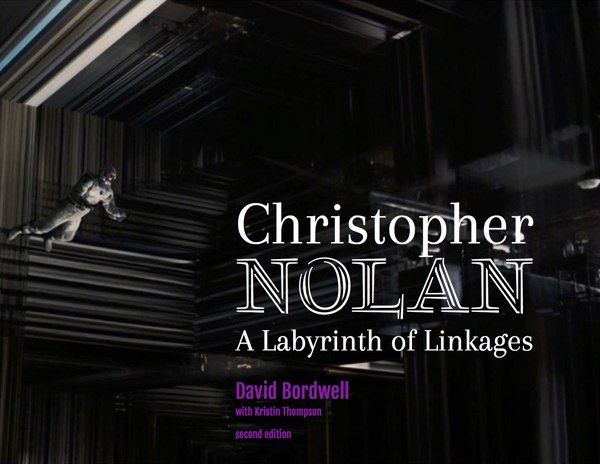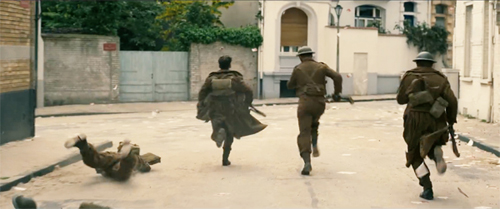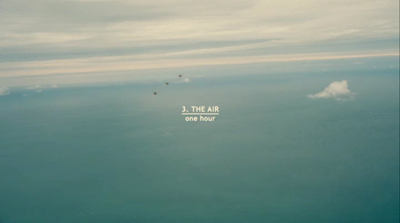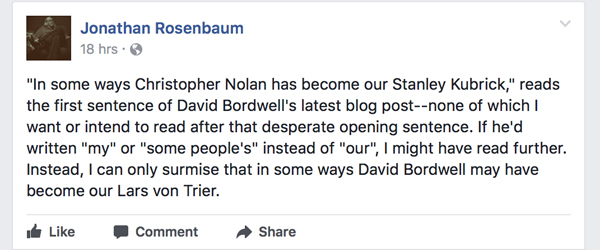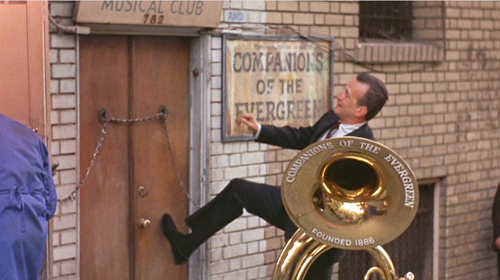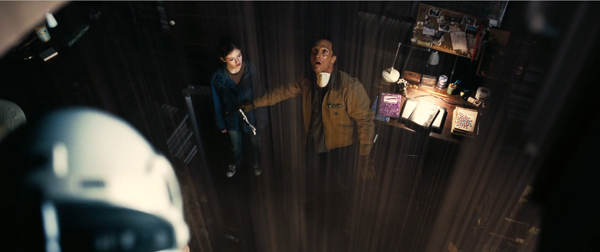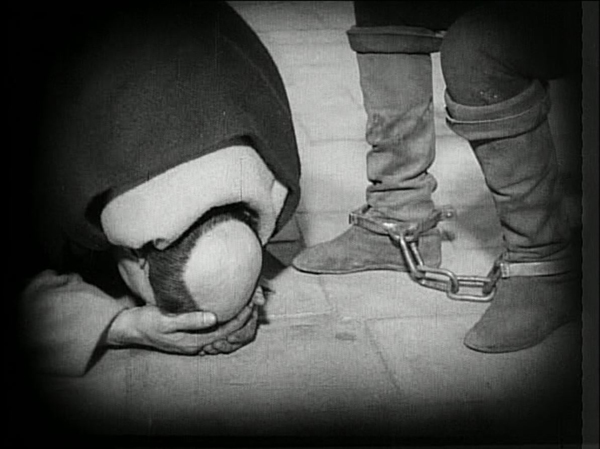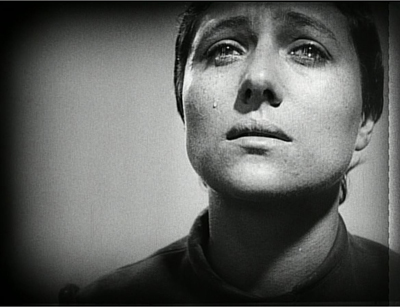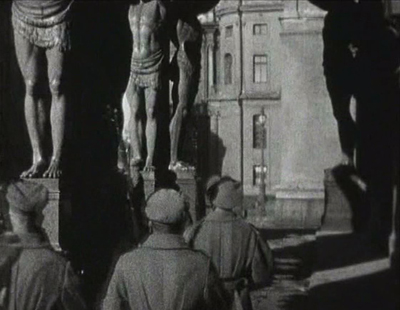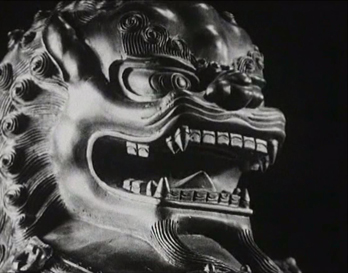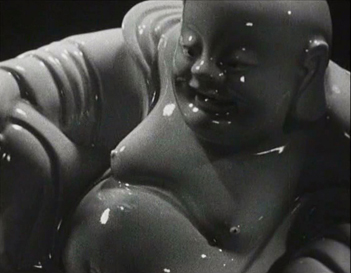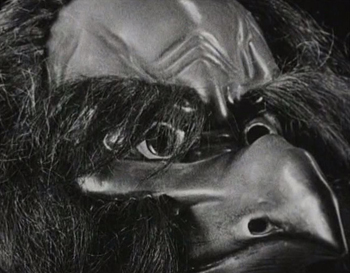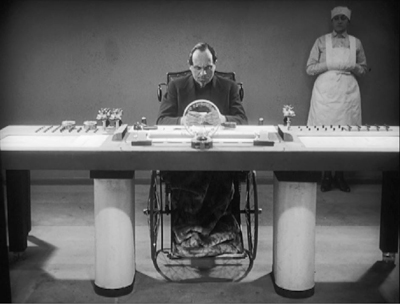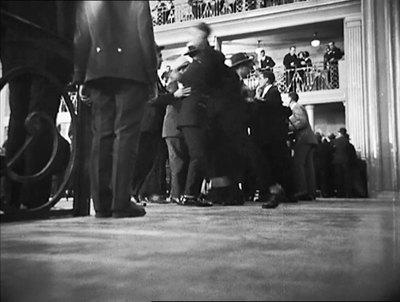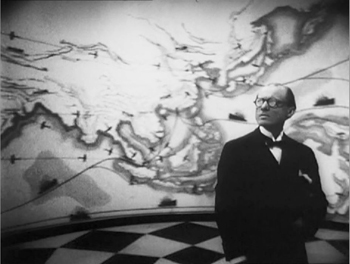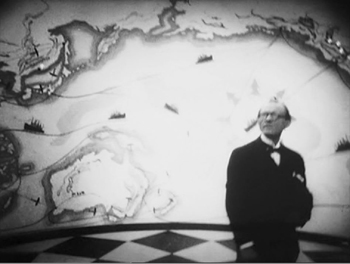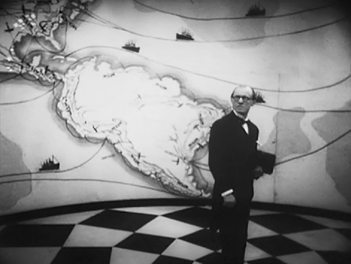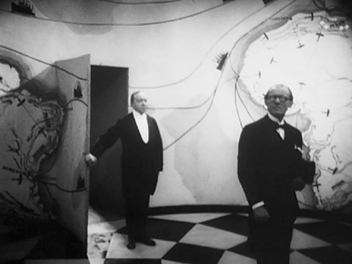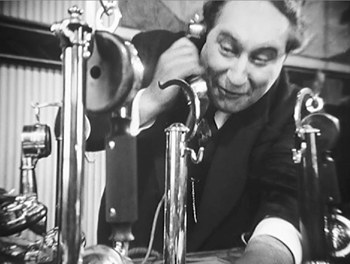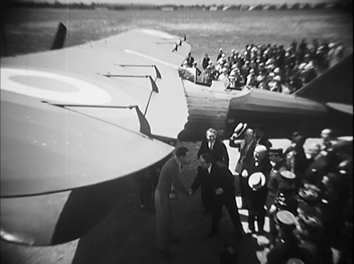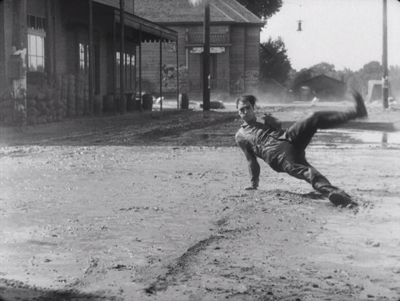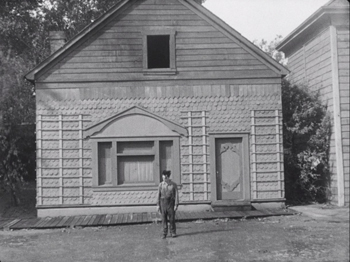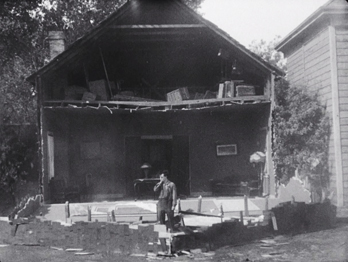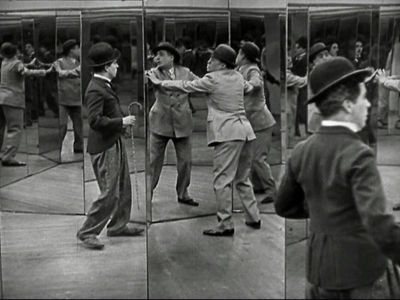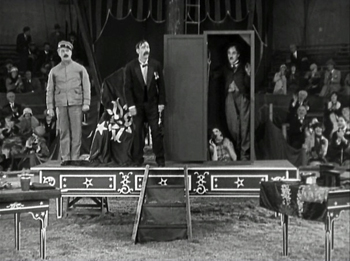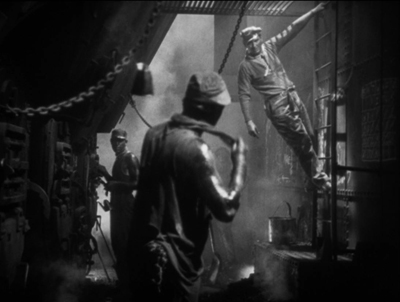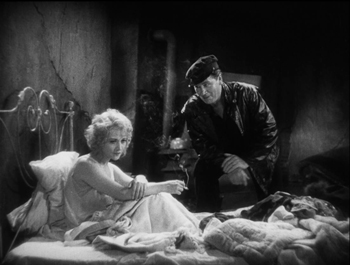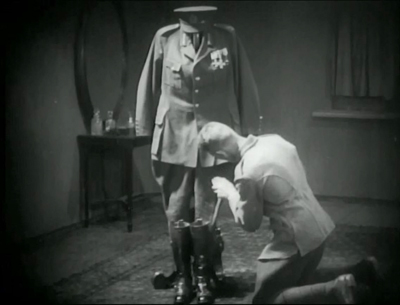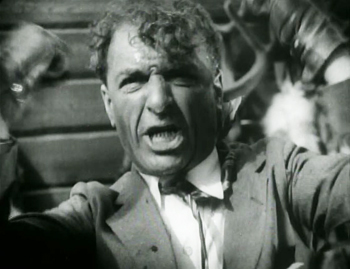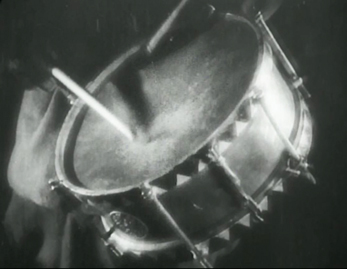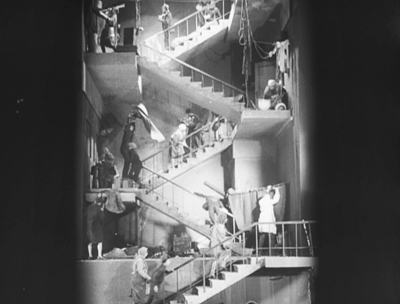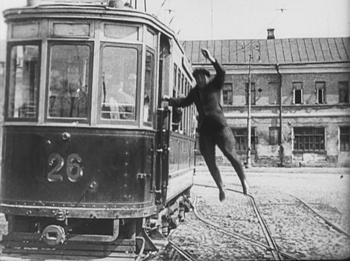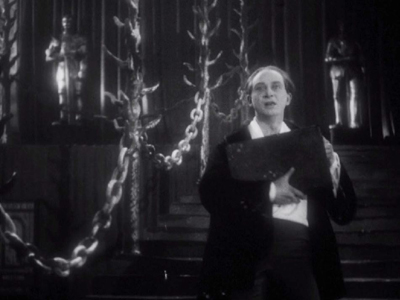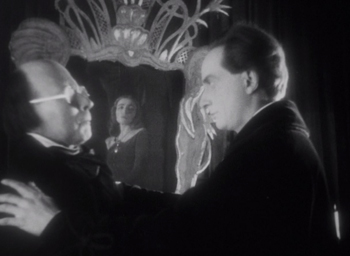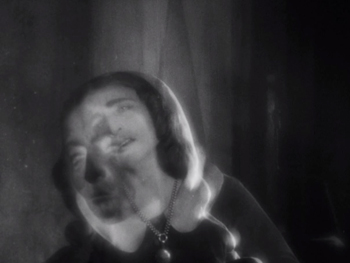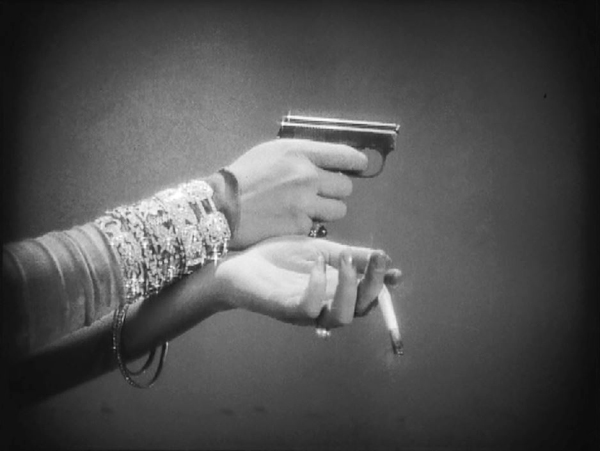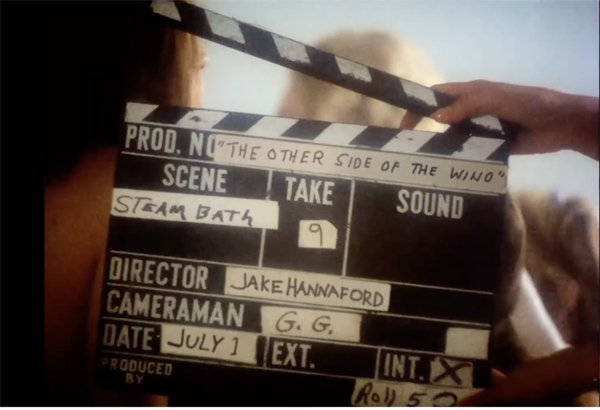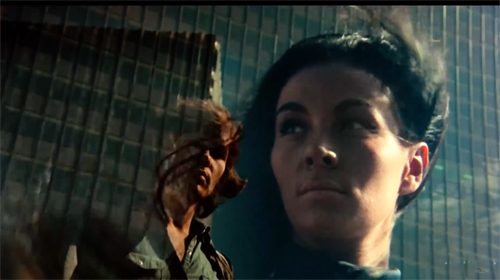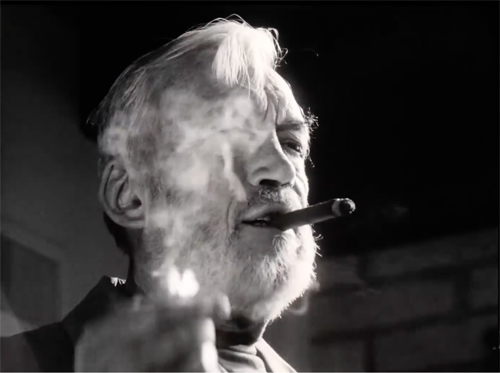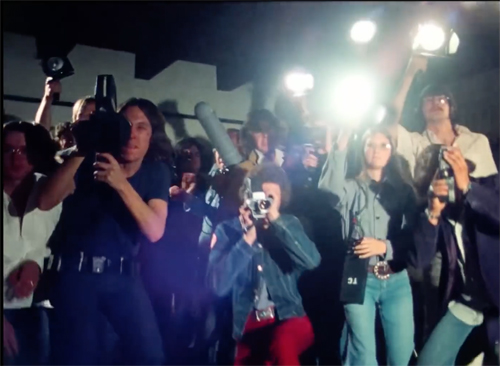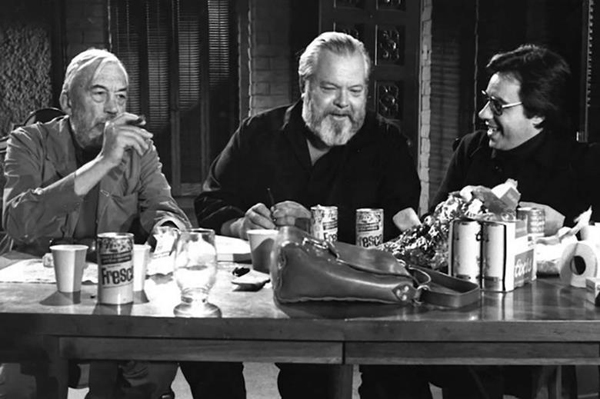Archive for the 'Readers’ Favorite Entries' Category
The Criterion Channel: The best news for film culture you will hear today (and probably all year)
DB here:
The Criterion Channel is up and streaming in the US and Canada as of today. You can browse the offerings here. Some basic questions are answered here. For help activating your account, try here.
Using Apple TV, I found it very easy to get access. I was immediately and flawlessly playing The Big Heat, Taipei Story, La Pointe Courte, and Le Amiche, that unjustly ignored Antonioni masterpiece.
For background and news on forthcoming options, check out this interview with Peter Becker. For those who miss the Hollywood side of FilmStruck, the Channel will be streaming studio-era classics as well as silent, foreign-language, and independent titles.
And all the extra features from FilmStruck–Adventures in Moviegoing, Ten Minutes or Less, Split Screen, Short + Feature, plus the supplements and interviews and bonus felicities you’ve come to expect from Criterion–will continue and accumulate in an archive. The menu includes our Observations on Film Art series, re-launching this month with me talking about flashbacks in Lydia. (It was up briefly in the waning days of FilmStruck. There’s a blog entry about it too.)
At some point, a vast array items from the Criterion/Janus library will be accessible as well. That’s the iceberg underneath the surface. How many films? Wait and see, and be astonished.
This is truly a momentous event in our film culture. We want to thank the Criterion team, all of them devoted film lovers, for working so hard to make this ever-expanding treasure-house available.
Under our Criterion Channel category, you can find all the blog entries devoted to our installments there, including those from the FilmStruck days.
Nolan book 2.0: Cerebral blockbusters meet blunt-force cinephilia
You want to go see a film that surprises you in some way. Not for the sake of it, but because the people making the film are really trying to do something they haven’t seen a thousand times before themselves. . . I give a film a lot of credit for trying to do something fresh—even if it doesn’t work.
Christopher Nolan
DB here:
Christopher Nolan has scheduled a new film for summer 2020. That’s all we know at this point. It’s a nifty coincidence that this week we’re releasing the second edition of our little e-book, Christopher Nolan: A Labyrinth of Linkages. It’s now available for purchase at $3.99.
Kristin and I have rewritten and expanded the 2013 edition to include discussions of Interstellar and Dunkirk. In addition, I’ve taken the opportunity to develop some new arguments about Nolan’s career. In particular, I claim that he has developed a consistent and fairly adventurous “formal project” revolving around the treatment of cinematic time. I also consider his efforts to make what the industry calls “event films” and The Hollywood Reporter calls “cerebral blockbusters.”
My online exploration of those ideas got me into trouble some while back. A well-known critic vehemently criticized my blog entry on Dunkirk while announcing that he refused to read it. His Facebook fulminations taught me a few things about internet culture and film reviewing, and I’ll try to spell some of them out shortly. First, though, let me introduce the new version of our book.
Preview
Dunkirk (2017).
The earlier edition was in portrait format and contained embedded video clips. The new version is squeezed into the more grateful landscape format and contains links to online clips. This makes the file less bulky to download. As you’d expect, we’ve added more clips, from The Prestige, Interstellar, and Dunkirk.
The book’s argument has four strands.
(1) Nolan is best understood as working with traditions and trends in contemporary American cinema. Following and Memento blend classic studio conventions (chiefly of film noir) with independent cinema’s tendency toward “complex storytelling” at the end of the 1990s (partly due to Tarantino’s influence). His Dark Knight trilogy aimed to bring serious themes to the emerging comics-superhero model. Our book has little to say about the Batman franchise, except insofar as it encouraged Nolan to try various stand-alone experiments.
A trend toward “intellectual” genre cinema, seen especially in The Matrix (1999), gave Nolan the opportunity to make his “cerebral blockbusters”; the Wachowskis’ film became a model for Inception. Important as well was the impulse toward richly realized story worlds (“worldmaking”) pioneered by Lucas’s Star Wars franchise and carried along in the fantasy and SF genres.
(2) Contemporary American cinema has enabled a few directors to launch “formal projects.” A filmmaker can develop a signature style or method recognizable from film to film. Wes Anderson is perhaps the clearest example in the US, although Hong Sangsoo is a good overseas instance. I argue that Nolan quite self-consciously launched a distinctive formal project in his work, applying it to a variety of subjects and genres. A new chapter develops this idea.
What is this formal project? I’d say it consists of experiments with cinematic time by means of techniques of subjective viewpoint and crosscutting. From Following to Dunkirk, Nolan has explored various ways of manipulating story time and the viewer’s experience of it. I devote a new chapter to spelling out the idea, taking seriously his emerging idea of a “rule set.” The rule set not only governs the film’s construction but becomes a guidance device that spectators must learn to understand the story.
After using Following and Memento to illustrate Nolan’s overall project, the book devotes later chapters to showing how rule sets shape The Prestige’s dual-protagonist plot, Inception’s nested-dream device, Interstellar’s time-travel agenda, and Dunkirk’s three levels of story duration. In the course of these chapters, I try to show how Nolan addresses criticisms that his work is emotionally cold (one chapter is called “Pathos and the Puzzle Box”) and how he has managed to develop his project in the framework of genres and studio “event pictures.” The biggest challenge is clarity: keeping the audience up to speed with story action when plotting and narration are fulfilling the sometimes arcane rules.
(3) The first edition of our book began by acknowledging that Nolan’s work divides audiences. Many film viewers like his films, some consider them masterpieces, and others consider them worthless. Here’s the new book’s opening, slightly modified from the first edition.
Paul Thomas Anderson, the Wachowskis, David Fincher, Darren Aronofsky, and other American directors who made breakthrough films at the end of the 1990s have managed to win either popular or critical success, and sometimes both. None, though, has had as meteoric a career as Christopher Nolan.
As of fall 2018, his films have earned over $4.7 billion at the global box office, and at least as much from cable television, DVD, and other ancillary platforms. On IMDB’s list of the top 250 movies, as populist a measure as we can find, The Dark Knight (2008) currently ranks number 4 with nearly two million votes, while Inception (2010), at number 14, earned over 1.7 million. Francis Ford Coppola, Steven Spielberg, and Peter Jackson each have three films in the poll’s top 50. Nolan is the only director to have five.
Remarkably, many critics have lined up as well, embracing both Nolan’s blockbusters and his more offbeat productions, like Memento (2000) and The Prestige (2006). From Following (1998) onward, his films have won between 76% and 94% “fresh” ratings on the aggregating website Rotten Tomatoes. Even Insomnia (2002), probably his least-discussed film, earned 92% “fresh.” Nolan is now routinely considered one of the most accomplished living filmmakers.
Yet some critics fiercely dislike his work. They regard it as intellectually shallow, dramatically clumsy, and technically inept. People who shrug off patchy plots and continuity errors in ordinary productions have dwelt on them in Nolan’s movies. The vehemence of the attack is probably in part a response to his elevated reputation. Having been raised so high, he has farther to fall.
More on the critical controversy below. At this point, it’s enough to say that our book argues that Nolan’s formal project illuminates certain capacities of cinema. He shows us some new things that cinema can do.
Innovation, then, is another strand in the argument. We pick up on Nolan’s suggestion that all other things being equal, innovation is worthwhile. (“I give a film a lot of credit for trying to do something fresh….”) Our opening chapter (“How to Innovate”), retained from the first edition, continues:
I admire some of Nolan’s films, for reasons I hope to make clear. I have some reservations about them too. Yet I think that all parties will agree that Nolan seeks to be an innovative filmmaker. Some will argue that his innovations are feeble, but that’s beside my point here. His career offers us an occasion to think through some issues about creativity and originality in popular cinema.
After decades of trying to trace the bounds of novelty in popular cinema, I think that Nolan’s work shows that the conventions of popular cinema are intriguingly flexible. As in the silent era (see many of our entries, especially those on the 1910s), as in the 1940s (see Reinventing Hollywood), as in the 1990s (see The Way Hollywood Tells It)—today’s American cinema can accommodate intriguing experiments in storytelling. There are limits, of course, but they aren’t as rigid or strict as some think.
Put more theoretically, the capacity of classical storytelling to exhibit “trended change” allows classical principles to be instantiated in various unforeseeable ways. This entry explains the argument a bit more.
4) Where does this leave the critics who despise Nolan’s work? The book argues that critics should be more open to the cinematic implications of the movies they encounter. They shouldn’t consider a film they may dislike merely as something to be dismissed or another nail in a despised director’s coffin or an occasion for displays of writerly cleverness. (The recent victim is Serenity. Maybe the umbrage is deserved, but it makes me want to take a look.)
Critics concentrating on evaluation can miss how even films they don’t consider good or likable can shed light on the possibilities of cinema. As our introduction puts it:
Taking this stance suggests that it can be useful to look at the artistic history of films apart from our urge to rate goodness and badness.
Once again, I find myself agreeing with Nolan’s remark quoted at the top of this entry. Even though something fails, it can be worth trying if it opens up some creative possibilities. Critics could signal these, if they chose.
These four ideas, along with detailed analyses of Nolan’s films, form the substance of the book. You can buy a copy on our order page, which contains more information and a table of contents.
The follies of Facebook
After the internet, nothing seems weird. Still, the August 2017 email from an overseas friend took me by surprise. It was headed “Re: Rosenbaum” and began: “What a turd!” before continuing in a similar vein.
Jonathan Rosenbaum has my permission to stop reading this now.
I don’t do Facebook or any other social media myself, so I had no idea what my friend was referring to. Using Kristin’s account, I learned that on a Facebook page JR had posted the remark you see above in response to my blog entry on Dunkirk. (That entry has developed into a chapter in our book.)
I was mostly bemused by the Facebookery. Actually, I didn’t understand it.
I didn’t understand the reference to Lars von Trier, whom JR has praised many times.
I didn’t understand what was desperate about my effort to grasp Nolan’s latest release as part of a larger trend toward event films as “personal” projects, typified in earlier times by Kubrick’s work.
I didn’t understand the objection to my use of “our,” which the entry clearly indicates as referring to mainstream US film culture today.
I didn’t understand how I could stagger someone by comparing two notable filmmakers. Nothing I said in what followed suggested I was comparing them on grounds of quality. Indeed, had JR checked our blog or read our book, he’d learn that I’ve written about both flaws and strengths of Nolan’s work.
Above all, I couldn’t understand why someone would refuse to read further, and then proudly tell his Facebook Friends™ he did it. This seems curiously close-minded, especially when six minutes of Googling dredges up many passages in which JR castigates critics for refusing to see movies they comment on.
Wolcott’s deepest scorn was reserved for those “sullen Village Voice reviewers” who “praise movies so obscure that simply getting to the theater counts as a quest for the authentic.” One of them, he pointed out, had the nerve to write hyperbolically about a recent Godard video — something that Wolcott presumably couldn’t be bothered to see himself.
“[Godard’s] most recent films,” I concluded, “are simultaneously investigations into and lessons about how to see, hear and understand our everyday existence. Regardless of how one ultimately judges them, it is irresponsible to call them frivolous; far more frivolous is the critical intelligence which refuses to grapple with them.”
I saw as well that some of his Friends™, who also had not read the piece, had joined the chorus. Still, Facebook isn’t exactly an arena of Ciceronian subtlety. So I shrugged. Why not let JR and his Friends™ blow off steam?
But a few of his Friends™ bothered to read my piece and pointed out that his reaction misunderstood my points. And some who hadn’t read the piece began treating my first sentence as an essay question in Contemporary Movies 101 by speculating on what evidence might warrant it. Indeed, some of his readers arrived at claims akin to mine.
JR responded by escalating. He had to go and compare me, on obscure grounds to Trump–a figure I’ve castigated on more than one occasion. To this I demanded an apology.
JR replied on Facebook with an excuse masquerading as an apology. As I’d predicted, he shifted the grounds of the original objection. Turns out it was my fault: he claims that my first sentence misled him because it was so poorly written. (Sorry to report, it remains in the Nolan book.) The whole thing–starting silly, turning a bit nasty, and ending with the critic scuttling off trailing a cloud of muttered gripes–exemplified yet again the superficiality that Facebook encourages.
My email correspondent might call it a close encounter of the turd kind. Still, I think I learned things. I began to think again about how criticism that depends heavily on evaluation can lead to a dogmatism about taste and a close-mindedness that blocks intellectual inquiry.
Call it blunt-force cinephilia.
A brief guide to militant cinephilia
Petulia (1968).
In an earlier entry, I argued that critics do lots of things with language. They describe artworks; they analyze them; they interpret them; and they evaluate them. Typically, academic critics concentrate on description, analysis, and interpretation. Evaluation usually takes the back seat.
By contrast, journalistic critics, aka reviewers, heavily weight evaluation. After minimally describing the film, they offer consumer recommendations. They guide us to recent releases that they favor and steer us away from ones they don’t. But evaluation, I claimed, can appeal to two standards: more or less objective criteria of judgment and more or less subjective tastes. The reviewer may appeal to criteria that readers share (a thriller shouldn’t have plot holes, a comedy should induce laughter), or to tastes.
Tastes are subjective, but they’re also shared with others. I like even somewhat cheesy kung-fu films, and maybe you do too. I’m not prepared to call them excellent on objective criteria, but they give me pleasure. A reviewer often signals a film’s taste dimension with “If you like this sort of thing, you’ll probably like this new film.”
But some reviewers, as they acquire knowledge of films and film history and film culture, build up a cluster of distinctive tastes. And some reviewers become well-known, and they gather followers. Soon the critic’s preferences and hatreds become part of the critic’s public identity, and the followers align their tastes, to one degree or another, with the critic’s.
And when a critic becomes a celebrity, he or she may be tempted to make tastes part of the brand, to minimize judgment based on criteria and exaggerate the importance of tastes. And to whale away on films aimed at alien tastes.
One branding option, popularized I think by Pauline Kael, was a sort of weaponized evaluation. Bad films weren’t simply slipshod or shallow, but they were outrages, profound insults to cinema and humanity. “Is there any art in this obscenely self-important movie?” Kael asked of Petulia.
Militant cinephilia of this sort offers all sorts of rhetorical advantages. It paints the possessor as a pure guardian of what’s valuable. It allows the critic to write wildly, spraying bullets at many targets, so it has a jittery readability. It encourages hatchet-wielding, since most films won’t measure up. Demolition jobs, like Godzilla movies, are fun.
Dogmatic cinephilia also favors the narcissistic personality who disdains dialogue or common pursuit of ideas. And it glamorizes the critic’s brand. Who would want to be sane, reasonable Stanley Kauffmann if you can cheer Kael wrestling with the demons of commerce? This is how cults of personality grow.
Militant cinephilia rests largely on the critic’s taste arsenal. Deployed carefully, it can yield good results–stimulating conversation, pointing out faults and beauties in films. But cinephilia turns dogmatic when the tastes keep you from considering evidence or alternative arguments. Ironically, the dogmatic cinephile winds up limiting cinephilia, and cinema itself.
As a sketch, I’d offer this list of symptoms of blunt-force cinephilia.
You see it or you don’t. The critic makes sweeping claims, usually in the form of piled-up adjectives, without much evidence.
Differ if you dare. The critic simply negates any opposing views by attributing disagreement to base motives or a blinkered assimilation to dominant tastes. You cashed in, sold out, unthinkingly accepted what you were told.
Fondness for the sideswipe. If dogmatic cinephiles were forced to justify their claims in some detail , they might nuance them. But reviews, like Facebook postings and tweets, have to be brief. (No time or space to go deep.) They favor short, sharp bursts of dislike, zingers, what in another context Matt Taibbi calls “anger chiclets.” The same scattershot approach can be found in longer pieces as well, where a celebrity critic can pile up strings of pans or panegyrics.
My cinephilia can lick your cinephilia. When you overstate (or “overreact,” as JR puts it in his Facebook apology), as you inevitably will, it’s because you just love cinema so much. Your passion is so volcanic that of course sometimes it will burst the bounds of reason. Never say “It’s only a movie!” Movies matter tremendously! See how much I care? My vehemence is righteous, and I smite the sinful.
The mutation of militant cinephilia into dogma brings us back to JR’s outbursts. If you’re a critic defining yourself largely by tastes, my fairly bland sentence about Dunkirk can look like an armed provocation. Dogmatic cinephilia can operate on a hair-trigger.
More basically, I suspect that JR doesn’t welcome film criticism that suspends or just ignores evaluation. But I think it’s not only possible but desirable to hold evaluation in check if we want to know how films work and work on us.
The writing we do on this blog and in our publications is of course fueled by love–of the medium, of filmmakers, and of films. Evaluation mostly enters as a choice of what to talk about. We tend to write about films we think are good by some criteria. Usually, we like them as well. Sometimes we try to convince you to rank them high and come to like them.
Still, many of our points should hold good independent of evaluation. Often we try to see films as affording glimpses into cinema’s artistic practices (conventions, strategies) and, when we encounter novelty, its fresh possibilities. This is at bottom the premise of the Nolan book.
Both journalistic reviewers and high-end critics often lack curiosity. They don’t seem to think that films can teach them anything about cinema they don’t already know. We, like Nolan in our opening quotation, want to be surprised by something, even if it doesn’t quite come off. At the limit, we try to learn things about cinema from films that others, or even we ourselves, might not like. That’s another valid way, we think, of being a cinephile.
For more on our Nolan book, see this entry.
An older blog entry considers other games cinephiles play.
Besides the Nolan book, what would criticism that plays down evaluation look like? Many of our blog entries and books try to hold judgment and tastes in abeyance in order to answer research questions about form and style. See, for an example of a film that has ardent supporters and skeptics, our entries (here and here) on La La Land. For a wider effort to compare several films without emphasizing value judgments, try my roundups of narrative strategies in releases of 2015 and 2017. Then there are the older essays on Mission: Impossible III and staging in 1910s Nordisk films. For more extended examples see the book Poetics of Cinema.
Interstellar (2014).
The ten best films of … 1928
La passion de Jeanne d’Arc
Kristin here:
Time for our twelfth annual alternative to the usual list of the ten best films of the current year. Instead, I offer a list from 90 years ago, in part for fun and in part to call attention to some lesser-known classics that are worth discovering. (See here for our lists from 1917, 1918, 1919, 1920, 1921, 1922, 1923, 1924, 1925, 1926, and 1927.)
The year 1928 marked the triumphant conclusion of the silent cinema. Very few sound films were made that year, and those that were often included only music, perhaps sound effects, and occasionally some passages of dialogue. Sound was not innovated because the silent cinema was in aesthetic decline. Quite the contrary. It was initially an enhancement that film-industry people assumed would make films more lucrative. In most cases the “talkies” that followed over the next few years were inferior to their silent predecessors, in part due to the limitations of the new sound technology. Those who opposed the addition of sound could point to the films of 1928 as evidence that the young art form had already reached a peak of perfection that was being tarnished by the addition of recorded sound.
In compiling this year’s list, I came up with eight titles that seemed unquestionably to belong on it. There were another six on a list of possibilities for the final two slots. More than in past years, this year gave me a chance to go back and rewatch films I hadn’t seen in a long time, in some cases since graduate school in the 1970s. Some held up well, some not so much. In a few cases, restorations made since my first viewings revealed new strengths in films I remembered from poor prints.
As always, there are films that have been lost but which plausibly could have filled out the list, most notably Ernest Lubitsch’s The Patriot and F. W. Murnau’s 4 Devils.
First, the eight obvious choices, in no particular order apart from #1.
1. La passion de Jeanne d’Arc.
Not every year includes a film that is not only one of the tops of its year but of all cinematic history as well. Carl Theodor Dreyer’s final silent film is one such masterpiece.
Jeanne d’Arc seamlessly blended the stylistic traits of the great artistic film movements of the 1920s, German Expressionism, French Impressionism, and Soviet Montage and made something new and unique of them.
Expressionist designer Hermann Warm’s past credits had included two films that have featured in these lists, Robert Wiene’s Das Cabinet des Dr. Caligari and Fritz Lang’s Die müde Tod. Warm collaborated with French theatrical designer Jean Hugo to create spare, white, off-kilter sets that focus our attention on the spiritual drama. Fast editing conveys subjectivity, as in the scenes where Jeanne is threatened with torture and where the citizens are suppressed when they riot after her execution. Rudolph Maté’s cinematography is startlingly dependent on close shots, particularly on the face of Jeanne, played by Renée Falconetti in one of the most intense and affecting performances in any film.
The steady progression of the action condenses days of trial testimony into one apparently continuous story. Between the sets and this inexorable march toward Jeanne’s martyrdom, there is a sense of both spatial and temporal disorientation that focuses our attention intensely on the central conflict.
Until 1981, prints of Jeanne d’Arc were indistinct and incomplete. A pristine print that restored the original visual quality and detail was found in Norway. (The film was among the early ones to be shot on panchromatic film stock without the actors’ using makeup. The result is a detail of texture in the faces that enhances the performances tremendously.) This print is the basis for the Criterion Collection’s edition of the film.
It’s a film that one can see over and over and still be overwhelmed at the originality and intensity of Dreyer’s vision. We saw it projected last November in Houghton, Michigan, with Richard Eichhorn’s recently composed accompaniment, “Voices of Light,” essentially an oratorio and film score rolled into one. We were somewhat trepidatious about whether the score would be distracting, but it proved very effective. Once again, I was reminded of how great this film is. (“Voices of Light” is an optional accompaniment on the Criterion edition linked above.)
2. October
If Jeanne d’Arc gains intensity through a nearly claustrophobic treatment of space, Sergei Eisenstein creates an epic tenth-anniversary celebration of the 1917 Revolution in his October (finished and released a year late).
Perhaps the most extreme example of Soviet Montage’s frequent avoidance of a single protagonist, October cuts among a wide variety of the people involved in the revolution. Workers pull down a statue of the Tsar. Lenin speaks at Finland Station. Kerensky and his officials luxuriate in their Winter Palace headquarters. Sailors wait on the Aurora battleship. Elderly citizens try to protect the specious February Revolution. Female soldiers are summoned to protect the Palace from the attacking Red forces. Looters steal bottles from the Tsar’s wine-cellar. The result is a sort of patchwork collage of the Revolutionary events leading up to the storming of the Winter Palace and the attack itself, with a slow build to an exultant climax as the Red forces triumph.
Eisenstein was given extraordinary access to the locales of the actual events, so that the vast halls of the Winter Palace and the trappings of royalty (Fabergé eggs and fancy crystal liquor bottles) give a sense of reality rare in fictional reenactments. (There was a time when October was plundered for “documentary” footage of events which had not been recorded by cameras at the time.) He used the settings to ridicule the anti-revolutionary forces, as when young cadets are summoned to help fight the Red forces and are dwarfed by the muscular colossi that line one area of the Palace’s exterior (above).
The film also represents Eisenstein’s experiments with “intellectual montage,” where he attempts to convey ideas strictly through juxtaposing series of images. In belittling the phrase “for God and country,” he tries to reduce the notion of “God” to absurdity by linking a long series of increasingly exotic depictions of deities from different religions.
Whether Soviet audiences of the late 1920s could make anything of such passages is impossible to know for sure, but one suspects that some of them would have been incomprehensible. Still, it is exciting to see an artist playing with such possibilities. Certainly the technique lived on, whether from the simple juxtaposition of cackling hens and gossiping women in Lang’s Fury or Jean-Luc Godard’s dense, often impenetrable strings of images, especially in his political films.
October exists in many versions. Beware the heavily cut versions under the title Ten Days That Shook the World. These images were taken from the 2008 release by the Soviet Ruscico company in its “Kino Academia” series.
3. Spione
Despite the widespread enthusiasm for Lang’s Metropolis, his other big films of the 1920s–Dr. Mabuse, der Spieler, Die Nibelungen (Siegfried and Kriemhilds Rache), and Spione–seem to me better. Metropolis is perhaps flashier in its design and conception and certainly very entertaining, but it’s also sprawling and implausible and essentially pretty silly.
Spione, on the other hand, has a tight, fast-paced narrative. It’s sort of Dr. Mabuse boiled down to one feature instead of two, and with the villainous Haghi (again played by Rudolf Klein-Rogge) as a banker secretly masterminding a spy ring rather than a gambling racket. There are no great “heart vs. hand” themes here–just a rattling good tale stylishly presented. Expressionism has disappeared in favor of a streamlined look (above), and Lang’s editing has sped up since Mabuse.
There’s not much point in detailing the plot here, since it would involve too many spoilers. Discover it for yourself if you haven’t already.
Spione circulated for years in the truncated American release version, which is how I first saw it. A 2004 Murnau Stiftung restoration of the complete version was a revelation, not only for its more complete narrative but for its superb visual quality. It’s a feast of shots that only Lang could have composed (above and bottom). These frames are from the Eureka! DVD, but the company has subsequently released it in dual format DVD and Blu-ray. Kino Classics has also released it in Blu-ray. The same company has put out a boxed-set of all Lang’s silent films (including Die Pest im Florenz, directed by Otto Rippert from Lang’s script). We were given this recently and haven’t had time to explore it, but it looks like a must for any fan of Lang.
4. L’Argent
Marcel L’Herbier makes his second and final appearance on this annual list with his epic adaptation of Emile Zola’s L’Argent, updated to contemporary Paris. (See the 1921 entry for El Dorado; I also wrote about the Flicker Alley releases of the restored versions of L’Inhumaine [1923] and Feu Mathias Pascal [1925].)
Inspired by Abel Gance’s even more epic Napoléon (1927), L’Herbier set out to make a film that would require a large budget. To obtain that, he made a deal for his own company, Cinégraphic, to co-produce with the mainstream studio, Cinéromans. The result contains brightly lit sets of big banks and expensive apartments, as well as shots made in the Paris Bourse over a three-day weekend (above). L’Argent also had an all-star cast. It included Brigitte Helm and Alfred Abel fresh off Metropolis, thanks to the German distributor, UFA. It also meant that Cinéromans tampered with the film, re-editing and shortening it.
Given L’Herbier’s reputation as an aesthete and an avant-garde filmmaker, L’Argent was dismissed by many at the time as a purely commercial endeavor. It remained unseen and hence virtually forgotten for decades. A screening at the New York Film Festival in 1968 surprised and impressed the spectators. The real recognition of the film as a major artwork came, however, in 1973, when critic and theorist Noël Burch published his monograph, Marcel L’Herbier (Paris: Seghers, 1973). In it he hailed L’Argent as a masterpiece, devoting the entire final chapter to an analysis of it. Burch also wrote the entry on L’Herbier for Cinema: A Critical Dictionary: The Major Film-makers ([New York: Viking Press, 1980], Vol. Two, pp. 621-28), edited by Richard Roud; again Burch devoted much of his text to L’Argent.
I have expressed my reservations about L’Herbier’s films in earlier entries, but for me L’Argent is the big exception: stylistically daring and narratively engaging. Perhaps adapting Zola led L’Herbier to make a more conventionally suspenseful film than usual. Referring to the French Impressionist movement in general, Burch wrote, “L’Argent undoubtedly marks the end of the period of experimentation, since it is itself the culmination of all these experiments–not just L’Herbier’s, but those of the first avant-garde and even, to a certain extent, of the entire Western cinema (with the exception of the Russians)” (Roud, pp. 624-25).
The story involves two powerful bankers who spar for control of one large bank’s standing on the stock market. One, the villainous Saccard, aims to send a famous aviator on a perilous flight across the Atlantic to promote his bank’s oil holders in Latin America–while seducing the aviator’s wife during his absence. The other, Gundermann, tries to thwart him by buying up shares of his rival’s bank and then selling them to cause a drop in the bank’s value.
In portraying all the complex machinations going on, L’Herbier adopts a restless camera, frequently moving among and around characters rather than following them. The most striking example comes early on, when an underling comes to visit Gundermann and waits in an odd, unfurnished room decorated with a map of the world. As he looks around, the camera circles him until a servant unexpectedly appears through a door and escorts him in.
The odd distortions in these shot exemplify another cinematographic technique that was in increasing use during the late 1920s: conspicuous wide-angle lenses. On the left below, Saccard is nearly dwarfed by one of his telephones, while on the right the scene of the aviator’s departure makes the plane’s wings jut into the foreground and extend far into the background.
There are some subjective moments, carrying forward the tradition of French Impressionism. Yet for the most part the restless camera, the distorting lenses, the odd angles (see the top image of this section), and the unusual crosscutting are not subjective, which makes this an atypical Impressionist film. Instead they suggest the unnatural, disconcerting world of capitalism, of money and those who struggle over it. Perhaps by minimizing character psychology and striving to represent more abstract concepts, L’Herbier briefly carried Impressionism to a more political–and dramatic–level.
In 2008, L’Argent was released on DVD by Eureka! in the UK as a “Special 80th Anniversary 2 x Disc Edition.” The source material was a beautiful fine-grain positive struck from the original negative, with something close to L’Herbier’s original intended cut. It includes Jean Dréville’s Autour de “L’argent,” a 40-minute making-of (surely one of the first of its type), recorded during the original production. The DVD is still in print and is, as far as I know, the only release of this restored version.
5. Steamboat Bill Jr.
This was the first Keaton film I ever saw, and I immediately became a fan. (The director is credited as Charles Reisner, but we all know that Keaton was primarily responsible for the direction of his films of this period.) It’s not as good as The General (what is?), but it beats out The Cameraman, Keaton’s other feature of this year, by a nose.
Keaton plays the dandified son of a gruff steamboat owner. He returns home from school and gets put into working clothes by his father, whose deteriorating steamboat is competing for tourists with a larger, newer boat. Naturally young Bill is in love with the daughter of the other steamboat’s owner. The action mainly consists of Bill, Sr. trying to prevent Bill, Jr. from clandestinely meeting his girlfriend.
There’s lots of humor along the way to the climax, in which a huge storm hits the town. It’s a classic sequence of Keaton pulling variant gags on the situation of being in a high wind (above) and surrounded by collapsing buildings and flying objects. Perhaps Keaton’s most famous, and dangerous, gag comes when he pauses in front of a house’s façade, which tears loose and falls straight down on him–with a window sparing him from being crushed.
Reportedly the top of the frame missed his head by six inches, but we know Keaton was a little crazy in how far he would go for a laugh.
Steamboat Bill, Jr. was the last film Keaton made with his own production company. The Cameraman was made at MGM, and though it is very good, thereafter his career slowly declined after his move to that studio. This will, alas, be the last Keaton film represented in this series.
6. The Circus
Coincidentally, The Circus was the first Chaplin film I ever saw. I happened to take my first film course at the point where Chaplin had re-released The Circus, accompanied by a new musical score he composed himself. (Skip, if you can, the added opening, with Chaplin singing a maudlin song over an excerpt from later in the film.) The re-release was 1969, though I must have seen it in 1970 at Iowa City’s art-house, the Iowa. (Also coincidentally, my father managed the Iowa when he was at the university there on the GI bill in the years immediately after World War II. He was dating my mother at that point, and there she saw Day of Wrath. Hence when David and I became a couple in the mid-1970s, she understood what the book he was currently working on was about. But I digress.)
The print I saw at the Iowa was pristine.
Up to that point, The Circus had been unavailable to most viewers, though I suspect bootleg prints circulated among collectors. It’s among the least known of Chaplin’s features, and it’s still hard to see. There’s a Park Circus DVD available in England, consisting of the re-release version equally in mint condition; that’s the one I’ve taken these illustrations from. More recently the film has been released as a Blu-ray/DVD combination. There is also an Artificial Eye Blu-ray available, which gets high marks from DVD Beaver. I haven’t seen this and don’t know whether it’s the re-release version or the original.
Chaplin plays his Little Tramp character, introduced wandering around the sideshow attractions near a circus. Mistaken for a pickpocket, he flees among the booths, occasioning a brilliantly staged triple scene in a hall of mirrors. When he first enters it, he is alone and struggles to figure out how to exit. A short time later, pursued by the pickpocket, the two stumble into the room, and a comic chase ensues (above). Finally, a cop is chasing Charlie, who tries to confuse him by luring him into the mirror maze. It’s a set of gags that builds, with the figures popping unexpectedly into the foreground when we had assumed that the real actors were in the depth of the shot. Each scene in the maze is handled in a single take from the same camera setup.
The flight from the cop leads the Tramp into a failing circus cursed with a group of highly unfunny clowns. Charlie inadvertently and unwittingly becomes a sensation for his antics, including his invasion of a magician’s act.
The cruel circus owner hires him, supposedly as a prop man, and the show becomes a huge success. Charlie falls for the maltreated daughter of the owner, who in turn becomes smitten by a handsome tightrope walker. Trying to impress the daughter, the Tramp goes on when the tightrope walker fails to show up one day. The result is a classic extended scene of Charlie on the high wire, executing a series of comic moments before the whole thing is topped off by a group of monkeys who escape and end up swarming over him as he struggles to keep his balance.
I hope now that The Circus is becoming more available, it can takes its place beside Chaplin’s other features.
[December 29: Thanks to Valerio Greco for alerting me that a restoration of the original version of The Circus is underway in Bologna, to be released by The Criterion Collection.]
7. The Docks of New York
I’ve already written about this, Josef von Sternberg’s final silent feature, in 2010 on the occasion of The Criterion Collection’s release of it alongside Underworld and The Last Command in an essential box-set. The six films von Sternberg made with Marlene Dietrich after she came to Hollywood generally get more attention than any of his silents. If I were allowed three of his films for a proverbial desert-island situation, I would take Underworld, The Docks of New York, and Shanghai Express.
Docks is a concentrated dose of the atmospheric cinematography the director is famous for, in this case employed to create the grungy settings of the film. In the opening, the oil and sweat on the stokers’ bodies (above) is palpable, and the fog, hanging nets and lanterns, and smoke of the dockside sets establish the sleezy, hopeless milieu that drives the heroine to attempt suicide.
Apart from the impressive visuals, the film gains much of its appeal from its two central performances. Betty Compson manages to gain our considerable sympathy for “the Girl” in a remarkably short time, and she has to–the film is only 75 minutes long and she spends her first onscreen appearances unconscious after her near-drowning. George Bancroft, known mostly for supporting roles in westerns, came into his own as the protagonists of three von Sternberg films–including Thunderbolt but not The Last Command. Here he again plays the big lug with a well-hidden heart of gold.
Unfortunately the von Sternberg silents set from The Criterion Collection is out of print. Track it down somewhere or hope for a Blu-ray release.
[December 29: Peter Becker of The Criterion Collection tells me that, although a Blu-ray release is not yet scheduled, there is a good possibility that it will happen.]
8. Storm over Asia
After Mother and The End of St. Petersburg, Storm over Asia (the original title translates as “The Heir of Genghis Khan”) is the last of Vsevolod Pudovkin’s three great silent features. Unlike the first two, it is set in Mongolia. The Soviet industry officials were concerned to portray the Revolution in the various other countries that along with Russia made up the Soviet Union.
The story takes place during the Civil War years that followed the Revolution. A young Mongolian peasant tries to sell a valuable fox fur at a trading post, but the British dealer cheats him. The peasant strikes him and is forced to flee into the mountains, where he joins the Red partisans fighting the British imperialists. (This does not follow historical fact, since the British occupied parts of Siberia and Tibet, but not Mongolia. In reality, for a brief period in 1921, White Russian forces drove out the Chinese from Mongolia. In response, the Red Army moved in, supporting the Mongols in their quest for independence.)
The British shoot the protagonist but discover on him a document that seems to identify him as the heir of Genghis Khan. So they set him up as a puppet ruler in order to control the local population. Eventually he rebels and leads a storm-like assault that defeats his oppressors.
Storm over Asia uses many of the Soviet Montage devices that by 1928 were fairly conventional. For instance, there are many rapid, rhythmic alternations of shots. When the fur trader reacts angrily against the protagonist’s resistance to being cheated, brief shots of his angry call for troops to capture the young man alternate with shots of a drum being beaten. The final “storm” battle uses rapid montage as well. There is also the usual visual symbolism mocking the enemy, as exemplified by the empty officer’s uniform in the shot above.
Early Montage films tried to do away with a single central character in favor of a focus on the masses. October, for example, has no main hero. In Storm over Asia, though, the story arc is definitely crafted around the Mongol’s growth into a rebellious leader of his people. We will see Eisenstein opting for a central identification figure in Old and New (1929).
My illustrations were taken from the old Image release, apparently no longer available. The Blackhawk print has been released by Flicker Alley.
Those are the eight films I put on my “top” list. I thought of stopping there, but the number ten is sacred for such lists, plus part of the point here is to throw a spotlight on lesser-known films.
I gathered a second group of films that might claim the remaining two slots. These were mostly films that were already hallowed classics when I was in graduate school: King Vidor’s The Crowd, Jean Epstein’s La chute de la maison Usher, René Clair’s The Italian Straw Hat, and Victor Seastrom’s The Wind. Beyond that there were the more recently rediscovered and much admired film, Paul Fejos’ Lonesome and the still little-known The House on Trubnoya, by Boris Barnet.
Oddly, the three American films on this list have some distinct similarities. The Crowd and Lonesome are surprisingly parallel. Lonesome follows two lonely people in New York finding each other and falling in love in one hectic day. The Crowd starts with a somewhat similar situation–both even involve dates at Coney Island–but follows the couple through several years of happy times and misfortune during their marriage. The Wind is less realistic, dealing with a sensitive young woman who travels to the west and, plagued by the incessant wind and a real or imagined rape, slips into madness. All three strive to reject the conventional Hollywood romance. Unfortunately all three, however admirable for most of their plots, lead to abrupt, implausible happy endings.
I saw The Italian Straw Hat in my graduate-school days and found it remarkably unfunny, given its reputation. Returning to it now, I still find the first two-thirds largely devoid of humor. (The dance scenes during the wedding party seem interminable, with no little vignettes or gags among the characters at all.) The last portion picks up, but on the whole it’s hardly the model French farce it is held to be. Certainly Clair made a leap forward in skill and sophistication in his early sound films. (Les deux timides, also 1928, is no doubt a better film.)
The Italian Straw Hat probably owes its classic standing in part to the fact that the Museum of Modern Art acquired and circulated it early on. Curator and critic Iris Barry adored it and lauded it in a 1940 essay (reproduced in the booklet included in the Flicker Alley release.) I wonder how many others of the films considered classics have become so because they were among the few silents available in the decades before the 1960s, when film studies and archival curatorship began to be more comprehensive. Knowing the range of international films we know now, would these films have become quite so highly respected above others? I found myself reluctant simply to fill out my list with old standards. The choice was difficult.
Wanting to avoid carrying on the older canon at the expense of more recently rediscovered films for at least one of my films on this list, I always try to include a little-known but worthy film here. This year there is only one (if you don’t count L’Argent), and that is Barnet’s The House on Trubnoya.
The final slot goes to Epstein’s The Fall of the House of Usher. I have always considered this a somewhat tedious film, but the restoration of the film’s full length and improved visual quality in the Epstein box-set released in 2014 by La Cinémathèque Française makes it far more interesting and effective.
So here is the completion of my list.
9. The House on Trubnoya
Boris Barnet was a member of Lev Kuleshov’s school in the early years after the revolution. He played a major role in Kuleshov’s The Extraordinary Adventures of Mr West in the Land of the Bolsheviks, and he began directing films on his own with the wonderful serial, Miss Mend. He made more films, and some others may show up in our coming lists. Right now, there’s The House on Trubnoya.
The House on Trubnoya is included in Flicker Alley’s major DVD set, “Landmarks of Early Soviet Film.” (I can’t believe that we didn’t feature this on our blog, but it includes eight major Soviet films of the silent era.) The copy on the back of the box describes Barnet’s film as “often described as one of the best Soviet silent comedies.” I’m not sure that’s a major distinction, though Kote Miqaberidze’s Georgian satire My Grandmother (1929; available on DVD and Fandor’s Amazon streaming site) is quite funny, as is Ivan Pyriev’s The State Functionary (aka The Civil Servant; not, as far as I know, available on home video). But The House on Trubnoya is my favorite among the comedies I’ve seen.
It’s a satire on middle-class citizens’ maltreatment of their servants, though it doesn’t become Soviet-style preachy until well into the story. The film begins by setting up the titular house (on a well-known street in Moscow). We see it via its staircase and landings in the morning, rendered in a vertical view that looks startlingly like an iPhone image (above). It also recalls the seven levels in the staircase elevator shot climbing upward to 7th Heaven, though who knows whether Barnet had seen that by the time he planned his film. The residents of the various apartments emerge to use the communal stairway as a junkyard and work area, dumping trash, splitting firewood, beating curtains, and generally abusing the rules of the building, as one conscientious young Party member points out.
We are introduced to a barber, whose lazy wife makes him do all the chores. Then suddenly we’re with a professional driver with his own car. Just as suddenly we’re watching a peasant girl chase her runaway duck through a maze of traffic and nearly get hit by a tram. As the driver brakes hastily and jumps out to see if she’s hurt, there’s a freeze-frame.
A narrating title declares, “”But wait, we forgot to tell you how the duck ended up in Moscow.” Reverse motion leads to another title, “A day earlier.” A flashback to the heroine’s comic departure from a train station in the middle of nowhere shows the very uncle whom she is going to Moscow to visit arriving at the station just after she has left. Finding herself lost in Moscow with her duck, the heroine gains employment as a put-upon maid serving the barber and living in the house on Trubnoya. Her political awakening and the rehabilitation of the House on Trubnoya form the rest of the plot.
The House on Trubnoya is, in short, an imaginative, clever, and funny Soviet Montage film. Barnet’s other films are worth exploring as well. Check out The Girl with the Hatbox from 1927; it didn’t make last year’s top items, but it was on the long list.
10. La Chute de la maison Usher
Jean Epstein, who was probably the finest of the French Impressionist directors, has figured in these ten best lists before, in 1923 for Cœur fidèle, in 1924 for the little-known L’affiche, and 1927 for his masterly La Glace à trois faces.
I have long considered La Chute de la maison Usher interesting for its use of German Expressionist-inspired sets, but the fuzzy, incomplete prints that for decades were the only available versions made it difficult to enjoy. The restored version on the complete DVD set of Epstein’s works, which I discussed here, makes it far more interesting.
Taking its slim plot from Poe, the film follows a visit by an elderly man to the isolated castle of his old friend, Roderick Usher. Usher is painting a portrait of his beloved wife, but it is soon made clear that each time he presses the brush to the canvas, a little of her life is drained away–though the local doctor is mystified by her decline.
The film retains some of the traits of Impressionism, as when Madeline’s reaction to the effects of her husband’s painting are rendered in a superimposition of negative and positive images of her face.
The film has a minimal plot, but its focus is largely on experimentation in creating an eerie atmosphere. Shots of books falling in slow motion from their shelves, of curtains blowing in a cold wind that seems perpetually to invade the house, of frogs copulating in a nearby pond, and of the Expressionist-derived decors contribute less to a linear plot than to a mood of undefined menace.
The castle’s exterior is represented by obvious cardboard models, which tends to undermine the effect created by the interiors. The cheapness of these models is particularly noticeable in the climactic scene of the destruction of the house. This is unfortunate, but one must give Epstein credit for having done so much with so little.
This will be Epstein’s final appearance in our “Ten Best” lists, but I would like to call attention to his other 1928 film, Finis Terrae, the first of what the Epstein box-set collects as his “Poémes Bretons.” These are less Impressionistic, though Finis Terrae has a few impressive subjective shots. They are more realistic and poetic, largely involving the sea.
As I wrote at the beginning, 1928 was part of the period when the American industry was on the cusp of making sound standard in its films. Other national cinemas followed at various paces. One film that did not quite make my top-ten list demonstrates what must have worried film theorists and critics–and no doubt some filmmakers.
The restored version of Lonesome includes some dialogue sequences in a film otherwise accompanied by recorded music. There is an enormous contrast between the silent and sound footage. The story is largely told visually, but the dialogue scenes, clearly done in a sound-proof studio, are delivered in a stilted fashion by the young actors who are otherwise so casual and lively. The prospect of whole films being made in that fashion clearly disturbed lovers of films like La Passion de Jeanne d’Arc and Steamboat Bill, Jr. Watching Lonesome gives a dramatic insight into this slice of cinema history–a period that fortunately lasted only a few years as the technology improved and as filmmakers increasingly managed to make sound films that were just as imaginative, artistic, and engrossing as their silent predecessors.
January 6, 2019: Thanks to Docks of New York fan Tony Lucia for a correction on that section.
Spione
Venice 2018: Welles and THE OTHER SIDE OF THE WIND
DB here:
The Venice Biennale film festival unveiled to a panting cinephile public the long-rumored Welles film The Other Side of the Wind, now reconstructed thirty-three years after its director’s death. This is only one of many possible versions. Welles reportedly edited two scenes himself, including an erotic encounter in a rainstorm-shaken car, but the rest has been assembled from about a hundred hours of footage. (But see the PS in the codicil below.) Welles left many notes but no definitive script, so editor Bob Murawski, with guidance from many Welles experts, has carved out something that must stand as a best approximation what its initiator had in mind.
Approximation is also the word for my response. I need to see the film more than once in order to get to grips with it. Not that it’s a dense, complex work; I don’t think it is. It’s just that I need to shake off a sense of déja vu.
Or rather, déja lu. Having read about the film for years, I found almost nothing onscreen that I hadn’t been primed for by press coverage, by Joe McBride’s What Ever Happened to Orson Welles?, and by Josh Karp’s Orson Welles’s Last Movie. I found myself groping for a triple vision: How to imagine seeing the film fresh, without knowing its plot, characterization, and most pungent lines already? And then, how would it have looked and felt in the context of 1970s filmmaking? Finally, of course, how to consider it now, in the context of modern cinema?
Sorry, but I’m far from having an answer to any of these questions. Herewith, just some things that the film made me think about.
All together now
One persistent narrative premise, on stage and screen, might be called the climactic gathering. The plot is concentrated in a limited space and a short span of time–a day, or better, a night. The occasion is a meeting or party that brings together friends, acquaintances, associates, or kinfolk. As time passes, quarrels break out, old wounds rip open, and eventually family secrets and past transgressions are exposed. Examples of this dramaturgy are O’Neill’s Long Day’s Journey into Night, Albee’s Who’s Afraid of Virginia Woolf?, and films like Twelve Angry Men, A Wedding, Margin Call, and The Celebration.
The advantages of this format are many. The limits of time and place realistically assemble characters for intense confrontations, and those can be interwoven quickly to maintain audience interest. Actors like such a setup because the deterioration of civility that usually comes with the situation allows them to show a range of emotions that will culminate in bravura breakdowns. But the disadvantage is a certain obviousness: the secrets or suppressed feelings or traumatic memories will have to be stated rather nakedly. Subtlety may not be easy to achieve.
The Other Side of the Wind situates the climactic-gathering format in Movieland. After filming a stretch of director Jake Hannaford’s work in progress, called The Other Side of the Wind, cast and crew and hangers-on drive out to his house. The party aims to celebrate his seventieth birthday and, perhaps, enable him to drum up finishing money. A night of uninhibited drinking and verbal sniping is broken by screenings of parts of Hannaford’s film. At the climax, Hannaford drives away to a fatal car crash.
Welles, being Welles, puts new twists on the template. In Reinventing Hollywood, my book on 1940s cinema, I argued that he, like Hitchcock, was under unusual pressure to keep coming up with new ideas. Both filmmakers were so widely copied that they had to outrun their imitators. As Welles told Gary Graver, his loyal DP in his late years:
Somebody always has to be ahead of everybody else. I have to be steps ahead of everybody. I have to be more inventive and do things that nobody has done.
His urge to innovate helped fuel the fifteen years he devoted to shooting and cutting The Other Side of the Wind. This jaundiced satire of Hollywood displays some striking formal strategies–some original for the period, some familiar from his other work, but all an effort to galvanize audiences as he had throughout his career.
A man’s man
This Hollywood party is rendered in blunt satire and in-jokes. It’s haunted by Mr. Pister (Joseph McBride), a geeky film critic asking questions about phallic symbols and the camera’s quest for reality. A more acerbic critic, Juliet Riche (Susan Strasberg), is a stand-in for Pauline Kael, who wrote a notorious broadside against Welles. Peter Bogdanovich plays the implausibly named Brooks Otterlake, a younger, successful director who is both a disciple of Hannaford’s (he calls Jake “Skipper” and “Daddy”) and a rival to him. Familiar faces from the studio years–Paul Stewart, Dan Tobin, Mercedes McCambridge–as well as younger figures like Paul Mazursky and Henry Jaglom make appearances. This climactic gathering brings together New Hollywood and Old, even Elderly, Hollywood.
By casting John Huston as the lanky, roguish Hannaford, Welles adds an evocative layer to the citations. Welles had acted in several Huston films; now Huston is in front of the camera, his face resembling, in Dwight Macdonald’s phrase, a relief map of the Dakota badlands. He was nine years older than Welles, but he made his directorial debut with The Maltese Falcon in the same year as Citizen Kane. Significantly, his star rose after Welles’s fell. By the time Huston won acclaim with The Treasure of the Sierra Madre (1948) and The Asphalt Jungle (1950), Welles was unemployable as a Hollywood director and scrounging work in Europe.
Karp reports that Welles told Huston that his role was a critique of all egotistical directors—“It’s about us, John”—and Welles considered playing the part himself. But Welles wouldn’t have fit the more specific target the film seems to home in on, the swashbuckling filmmakers like Rex Ingram, Howard Hawks, and William Wellman. Huston embodied the hunting-shooting-fishing-punching persona to the full. In this context, Riche’s suggestion that Jake Hannaford harbors gay desires for his male stars takes on a special bite.
Was Welles taking jabs at Huston’s image? I have to wonder. While Welles was fleeing hotel bills and performing offhand magic on talk shows, Huston maintained an active studio career; he took leave from Other Side to make one of his biggest successes, The Man Who Would Be King (1975). At the least, Hannaford’s climactic gathering can be seen as another sort of convergence, bearing the traces of the contrasting 1970s fates of two prodigious directors who came up together.
Cameras and cutting
The notion of tracing a day and night in the lives of several movie people was sharpened by Welles’ decision to shoot The Other Side of the Wind in a reflexive cinéma-vérité style. Today we accept a grab-and-go documentary look as a legitimate approach to fictional presentation, but in Other Side the technique is given a realistic pretext. Anticipating the premise of The Office and other TV shows, Welles’ innovation was to provide specific sources for everything we see and hear: an array of cameras and tape recorders. Here even intimate exchanges are captured by at least one camera.
In a way, this idea reverts to Welles’ lifelong interest in the how of storytelling. His radio plays, under the rubric “First Person Singular,” often framed their stories within a narrator’s commentary. This Conradian inclination toward embedded tales, brilliantly managed in his Mercury radio adaptation of Dracula, emerged as well in Kane and The Magnificent Ambersons. Other Side’s mosaic of scenic bits harks back to the montage of sources (dance music, government announcement, network news bulletins, voice-over diary entries) that fill the War of the Worlds broadcast (1938).
Like Kane, Other Side opens with the main action already completed. An image of a crumpled car is accompanied by Bogdanovich/Otterlake’s voice explaining that Hannaford died in a crash after his party. (Apparently, Welles would himself have supplied this narration.) That explanation frames the footage that has been assembled documenting Jake’s last day on earth. Embedded in all that material, mostly black and white and in 4:3 format, are scenes from Hannaford’s last movie, in ripe color and widescreen and full of arty compositions and one frequently naked lady. Although they’re motivated as being projected to various audiences in the film, at the end some of the imagery seems to float free, being intercut with the documentary material.
The result is an extended experiment, more radical than even Rear Window, in the Kuleshov effect. Cuts between cameras and partyers, or people in conversation, are linked solely by our understanding of the context; there are few establishing shots. The cuts link shots that were made months or years apart, in any of the many houses Welles commandeered as his sets.
Admittedly, he had been up to such tricks before. The instructive documentary They’ll Love Me When I’m Dead (also screened at Venice) shows an example from Othello of shot/reverse shot cutting based on vast gaps in production time. But Other Side‘s shifting cast and locales have created Welles’s most disjunctive, fragmentary film. I counted about 2300 shots in 117 minutes, an average of three seconds per shot. He applied the same approach in F for Fake (1973), but that feels less scrappy because Welles’s buoyant voice-over glues everything together.
On this blog we try to practice a criticism of enthusiasm, writing mostly about films we admire and avoiding panning the films we don’t. Still, as a lifelong Welles fan, I can’t duck an initial appraisal.
I confess being disappointed by the film. I’m not ready to call it The Other Side of the Windbag, but I’m not sure it escapes the on-the-nose quality we often find in the climactic-gathering format. Here people must get both nasty and horribly transparent about baring their feelings. Moreover, the film-within-the-film, shot in glowing color and abstract cityscapes, is supposed to be a parody of Antonioni (Zabriskie Point in particular), but (a) most of it is more like a slick-magazine version of a trance film from the 40s like Meshes of the Afternoon; and (b) it’s inconceivable that even in the Love Era Hannaford’s project could receive commercial funding or release. It seems to me a bad idea of what a bad movie looks like.
Still, I’m trying to keep an open mind. Watching it more analytically and reading what critics write about it may open it up for me in ways I can’t now predict. For the moment, it’s satisfying enough to thank Netflix for enabling us to see in however hypothetical a form, what forty years’ fuss has been about.
As ever, thanks to Paolo Baratta, Alberto Barbera, Peter Cowie, Michela Lazzarin, and all their colleagues for their warm welcome of us to this year’s Biennale. I’ve especially enjoyed discussing The Other Side of the Wind with Peter, whose The Cinema of Orson Welles shaped my view of the director’s career way back in 1965.
My quotation from Gary Graver comes from Joe McBride’s What Ever Happened to Orson Welles?, p. 225.
For more on the Kuleshov effect, see “What happens between shots happens between your ears” and “They’re looking for us.”
Feel free to visit our Instagram page for an ever-expanding set of snapshots of the Venice festival.
P.S. 5 September 2018: Standard accounts suggest that Welles completed editing only two sequences. Alert reader Evan Davis points out that editor Bob Murawski says that Welles edited about 30% of the finished film. Thanks to Evan for this.
I apologize for the typos and whiffs in this entry; we’ve had unreliable access to the Net lately, and not all revisions took.
P.S. 8 September 2018: Ardent Wellesian Jim Naremore has created his own website, and it’s must reading for every cinephile. Right off the bat he gives us a thoughtful piece, “Orson Welles, Citizen of the World,” available in English only online. Watch for Jim’s essay on The Other Side of the Wind, slated to be published in Cineaste.
John Huston, Orson Welles, and Peter Bogdanovich on the set of The Other Side of the Wind.














